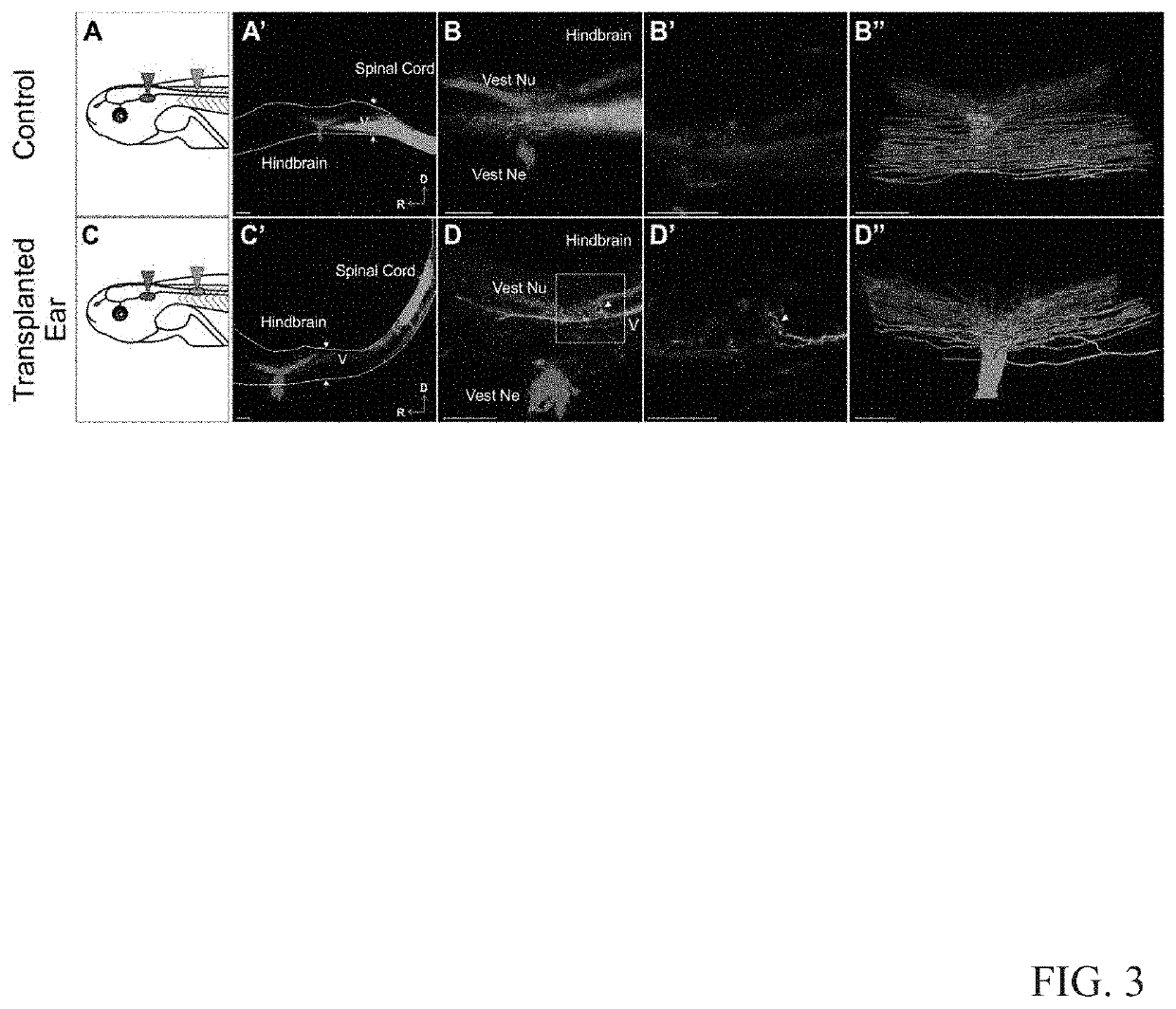Compositions and methods torestore hearing loss and balance through embryonic ear transplant
a technology of embryonic ear transplantation and composition, applied in the field of composition and methods for the restoration of hearing loss, can solve the problems of unsuccessful attempts to restore hearing after sensorineural hearing loss, and achieve the effect of restoring hearing loss and balan
- Summary
- Abstract
- Description
- Claims
- Application Information
AI Technical Summary
Benefits of technology
Problems solved by technology
Method used
Image
Examples
example 1
Animals
[0041]Xenopus laevis embryos of either sex were obtained through induced ovulation by injection of human chorionic gonadotropin, followed with fertilization by sperm suspension in 0.3× Marc's Modified Ringer's Solution (MMR, diluted from 10× stock; 1M NaCl, 18 mM KCl, 20 mM CaCl2, 10 mM MgCl2, 150 mM HEPES, pH 7.6-7.8). The jelly coat was removed with 2% cysteine in 0.1×MMR. Embryos were incubated in 0.1×MMR until having reached the desired stage for manipulation (see below), and until desired stages for tracing, behavior and physiological experiments (described below) as described by Nieuwkoop and Faber (1994).
Ear Transplantations
[0042]All surgical manipulations were performed in 1.0×MMR at room temperature. Animals were anesthetized with 0.02% Benzocaine (Crook and Whiteman, 2006) prior to and during all manipulations. Otic placodes and otic vesicles from donor embryos were removed and transplanted to recipient hosts at stage 25-27 and 28-36, respectively. Removed placodes ...
example 2
Methods
Animals
[0066]All animal work was conducted according to the Care and Use of Laboratory Animals and procedures were approved by the University of Iowa Institutional Animal Care and Use Committee (IACUC) (ACURF #1103057).
[0067]Fertilized chicken eggs were obtained from Hoover's Hatchery (Rudd, Iowa) and Aleta's Eggs (Belle Plaine, Iowa) and kept at 18° C. until incubation (maximum of 1 week at 18° C.). Eggs were incubated at 37° C. at 70% humidity for approximately 4 days prior to transplantation. Under our conditions, chicken embryos were between Hamburger-Hamilton (HH) stages 14-18 at the time of transplant, though most transplantations were performed between stages 16-18.
[0068]Wild type mouse embryos were obtained from pregnant females at embryonic day (E) 10.5. Pregnant females were anesthetized by injection of a lethal dose of Avertin (1.25% of 2.2.2-tribromoethanol at a dose of 0.025 ml / g of body weight) and decapitated. Uterine horns containing the mouse embryos were rem...
PUM
 Login to View More
Login to View More Abstract
Description
Claims
Application Information
 Login to View More
Login to View More - R&D
- Intellectual Property
- Life Sciences
- Materials
- Tech Scout
- Unparalleled Data Quality
- Higher Quality Content
- 60% Fewer Hallucinations
Browse by: Latest US Patents, China's latest patents, Technical Efficacy Thesaurus, Application Domain, Technology Topic, Popular Technical Reports.
© 2025 PatSnap. All rights reserved.Legal|Privacy policy|Modern Slavery Act Transparency Statement|Sitemap|About US| Contact US: help@patsnap.com



